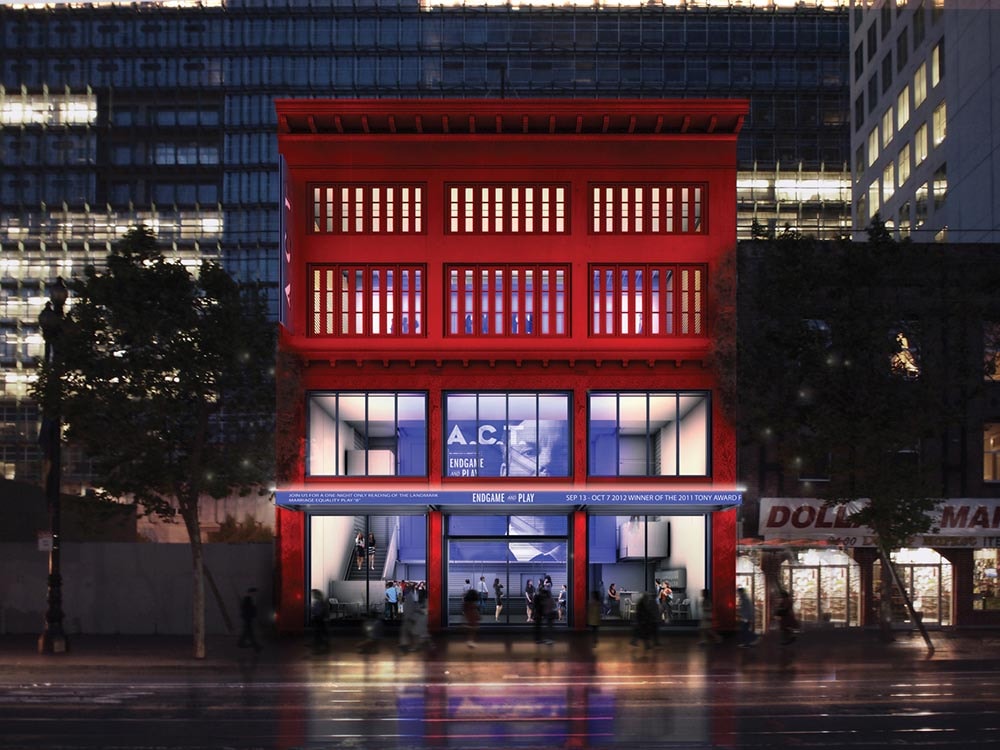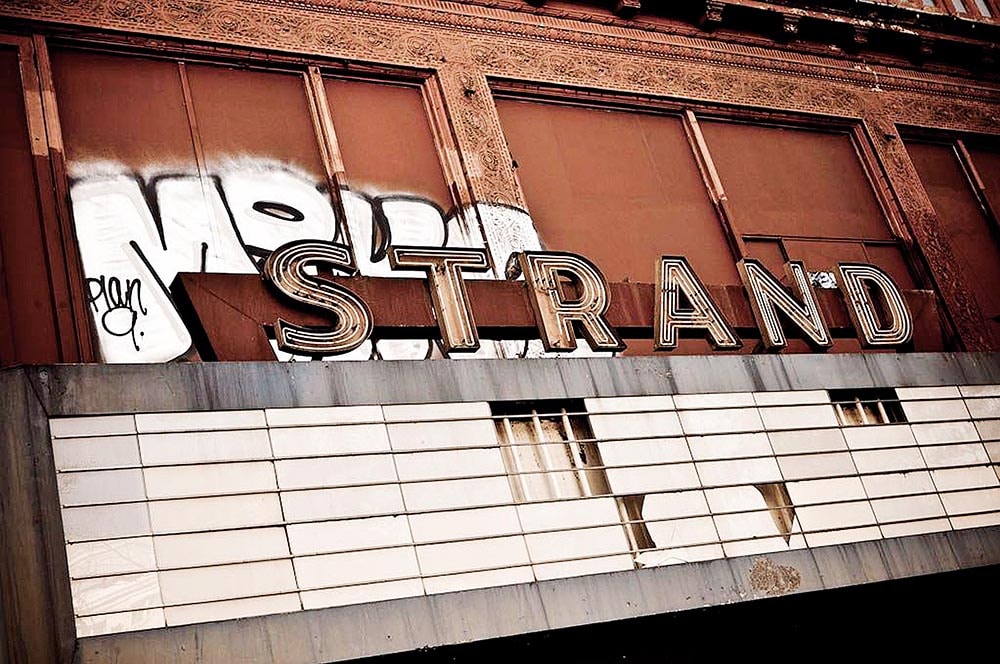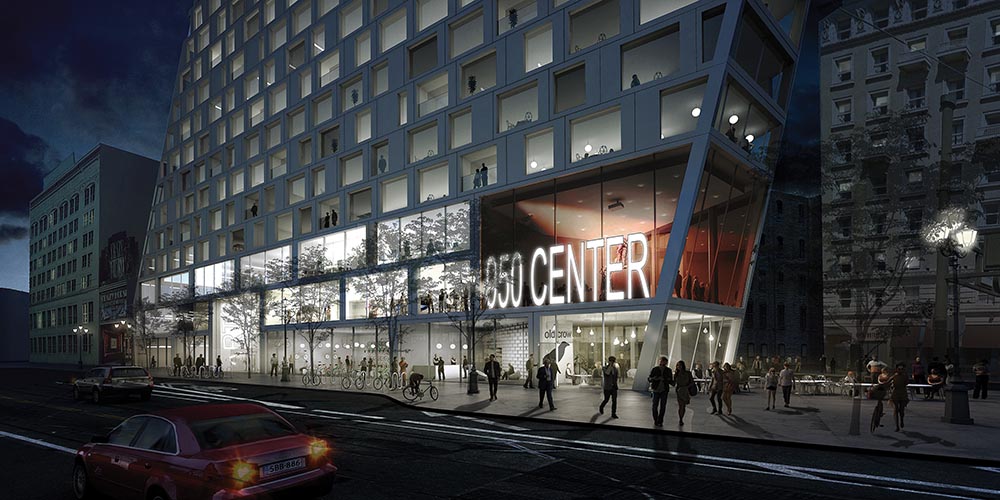One evening last December, a hundred or so activists marched down Market Street, San Francisco’s central thoroughfare, through the long-blighted but recently rising mid-Market corridor, just a stone’s throw from City Hall. They had come from a rally not far away, outside 1355 Market, the new headquarters of the tech giant Twitter, where they sought the attention of local and state politicians with signs carrying slogans like “Twitter Too Cool for School” and a vocal call for more equitable distribution of public funds—away from corporations and toward students, families and public education. At least one politician was among them: City Supervisor Eric Mar carried a sign reading “Stop Corporate Greed.”
The demonstrators’ route took them by American Conservatory Theater’s Costume Shop at 1117 Market, a black-box stage for ACT’s MFA students and—thanks to grants from the San Francisco Neighborhood Arts Collaborative and the Kenneth Rainin Foundation that make it available without charge to qualifying applicants—local companies, too. As the protesters paraded by singing pointedly modified Christmas carols, ACT artistic director Carey Perloff was inside convening the second in a series of discussions with members of the local arts community. The topic: hopes and fears surrounding the opening (scheduled for early 2015) of the Strand, a long-shuttered former porn theatre situated practically next door, at 1127 Market, and now being transformed into ACT’s stylish new two-stage venue.
The scene on the sidewalk and the scene inside the storefront theatre unfolded separately, but they were intricately related. Along this core stretch of Market Street, a civic drama is underway that encompasses not only new neighbors Twitter and ACT but many other arts organizations, including theatre companies, and other newly arriving tech companies, like Zendesk, Square, Yammer and Spotify. Both the arts groups and the techies are looking to secure space in a neighborhood that as recently as 2011 had the highest commercial vacancy rate of any in the city. This takes place amid a diverse population of mostly low-income residents, a sizable homeless population, small businesses, social service agencies and municipal government offices—all surrounded by the affluence, opulence and construction cranes of boomtown San Francisco.
Call them dramatis personae or call them stakeholders—all these groups are playing dynamic roles in the city’s ongoing revitalization of mid-Market, a neighborhood that has come to epitomize the rapid transformation of San Francisco at large, as well as the uncertain place of the performing arts in it.
From an overarching perspective, the issue is not just securing a place for artists and arts organizations in a rapidly gentrifying and increasingly expensive city, although that has already amounted to a serious challenge amid widespread displacement of San Francisco’s most financially vulnerable residents. It’s also about discovering a meaningful relationship between arts and development—one that does not cast the artist in the role of unwitting handmaiden to gentrification, but puts the arts at the center of community development, balancing a social mission with the workings of a roiling real estate market. To this end, several models have emerged from the mid-Market struggle that will help shape the city’s culture in the future—and should be of interest to anyone concerned with the place of performing arts in urban planning today.

Fifty years ago, Market Street, an historic artery and major transportation hub, brought people from miles around into what locals used to refer to as the city’s own Great White Way, a row of theatres and entertainments that was second to none among San Francisco neighborhoods. Several of the big theatres remain: the Warfield is a 2,300-seat music venue; the Orpheum and the Golden Gate, operated by SHN, bring in touring Broadway fare. Many smaller theatres live nearby—the EXIT Theatre, the Cutting Ball Theatre, Bindlestiff Studio, Boxcar Theatre, KUNST-STOFF and New Conservatory Theatre Center among them. But for years now, the mile-and-a-half of this downtown track known as mid-Market (or, in an attempt at rebranding, Central Market) has stood as an anomaly in a city shimmering with wealth and commerce—several long blocks’ worth of liquor stores, check-cashing places, head shops, strip clubs, street crime and vacant storefronts and lots, with the Tenderloin and SoMa (South of Market) as the deeply impoverished if vibrant flanks to the north and south.
Recently, partly as a result of actions put into motion by the mayor’s office, that picture has been noticeably changing. In January 2010, then Mayor Gavin Newsom charged his Office of Economic and Workforce Development (OEWD) with drawing up a plan for a public/private initiative that would guide a revitalization effort in the blighted mid-Market corridor (defined as that stretch of Market from Van Ness Avenue to 5th Street, and including a small swath of the Tenderloin and adjacent parts of South of Market). This effort was dubbed the Central Market Partnership. In November 2011, under Newsom’s successor Ed Lee, OEWD published the Central Market Economic Strategy. The report identified the arts community as one of seven neighborhood assets on which to build the revitalization effort.
Among those invited to join the Central Market Partnership’s regular meetings was Brad Erickson, executive director of Theatre Bay Area (TBA), the region’s performing arts service organization. “They wanted to know how many arts groups would be interested in moving into mid-Market,” explains Erickson, seated by the window in his office, which, as of last August, looks out onto the same shifting stretch of Market Street as ACT’s costume shop, TBA’s downstairs neighbor.
TBA obliged by conducting a survey of its membership. A large majority of respondents said they were interested in moving into mid-Market. “There was a lot of need for both venue and rehearsal space. This is before the big boom of now. So that was interesting. And out of that we got some money to go deeper.”



